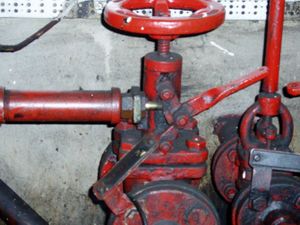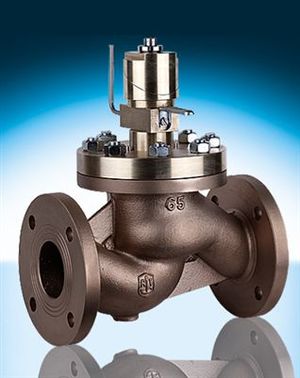Difference between revisions of "Fast Closing Valves"
| Line 1: | Line 1: | ||
[[Category:Valves]]{{Knoppen}} | [[Category:Valves]]{{Knoppen}} | ||
[[File:Quick Closing Valves.jpg|thumb|right|Fast Closing Valves]] | |||
[[File:Fast closing valves.jpg|thumb|right|Fast Closing Valves]] | |||
'''Fast Closing Valve''' is a valve or faucet whose automatic closure is fast-acting.An explosion involves not only the immediate process item, but can also propagate to the rest of the process. This propagation can be avoided if the affected process item is quickly isolated (compartmentation), thus limiting the consequences of the explosion to the process item in which it occurred.If the airflow is only minimally charged with dust, as in the case of the clean air outlet on filters, a fast closing valve is the ideal way to achieve isolation. | |||
Fast closing valve as a component of a fast closing system for protecting storage rings of synchrotrons and particle accelerators, other critical systems and applications.These [[Valves]] are ideal for rapidly isolating one section of enclosed ballistic range tankage from another . They can be used to prevent gun products or gases from contaminating impact products and/or to keep impact products from contaminating the launcher and uprange tankage or any other applications requiring the fast closing of an opening.The valves use a small explosive charge to drive an aluminum or plastic plug across a circular port. The plug is squeezed into a tapered hole creating an airtight seal across the port opening. | |||
On ships, marine diesel engines draw fuel from reservoirs or storage tanks which are also known as service tanks. All these tanks are provided with a specific valve known as fast closing valve, in order to shut the fuel supply in case ofemergency such as fire. The closing of the valve can be done either manually, hydraulically or even by using compressed air. A typical arrangement consists of wire operated valves with wire pull livers located externally to the machinery space. | |||
==Construction and working== | |||
Fast closing valve is a kind of pressure reducing valve in which the an automatic process control valve for fluid pressure control is used for unmanned machinery spaces. This can be done by careful selection of valve trim, i.e. the parts of the valve that come in contact with the controlled fluid and form an actual control portion. The difference between pressure release valve and fast closing valve is that the later does not come in direct contact with the fluid it is controlling. | |||
The | |||
Latest revision as of 10:18, 17 January 2013
Fast Closing Valve is a valve or faucet whose automatic closure is fast-acting.An explosion involves not only the immediate process item, but can also propagate to the rest of the process. This propagation can be avoided if the affected process item is quickly isolated (compartmentation), thus limiting the consequences of the explosion to the process item in which it occurred.If the airflow is only minimally charged with dust, as in the case of the clean air outlet on filters, a fast closing valve is the ideal way to achieve isolation.
Fast closing valve as a component of a fast closing system for protecting storage rings of synchrotrons and particle accelerators, other critical systems and applications.These Valves are ideal for rapidly isolating one section of enclosed ballistic range tankage from another . They can be used to prevent gun products or gases from contaminating impact products and/or to keep impact products from contaminating the launcher and uprange tankage or any other applications requiring the fast closing of an opening.The valves use a small explosive charge to drive an aluminum or plastic plug across a circular port. The plug is squeezed into a tapered hole creating an airtight seal across the port opening.
On ships, marine diesel engines draw fuel from reservoirs or storage tanks which are also known as service tanks. All these tanks are provided with a specific valve known as fast closing valve, in order to shut the fuel supply in case ofemergency such as fire. The closing of the valve can be done either manually, hydraulically or even by using compressed air. A typical arrangement consists of wire operated valves with wire pull livers located externally to the machinery space.
Construction and working
Fast closing valve is a kind of pressure reducing valve in which the an automatic process control valve for fluid pressure control is used for unmanned machinery spaces. This can be done by careful selection of valve trim, i.e. the parts of the valve that come in contact with the controlled fluid and form an actual control portion. The difference between pressure release valve and fast closing valve is that the later does not come in direct contact with the fluid it is controlling.

